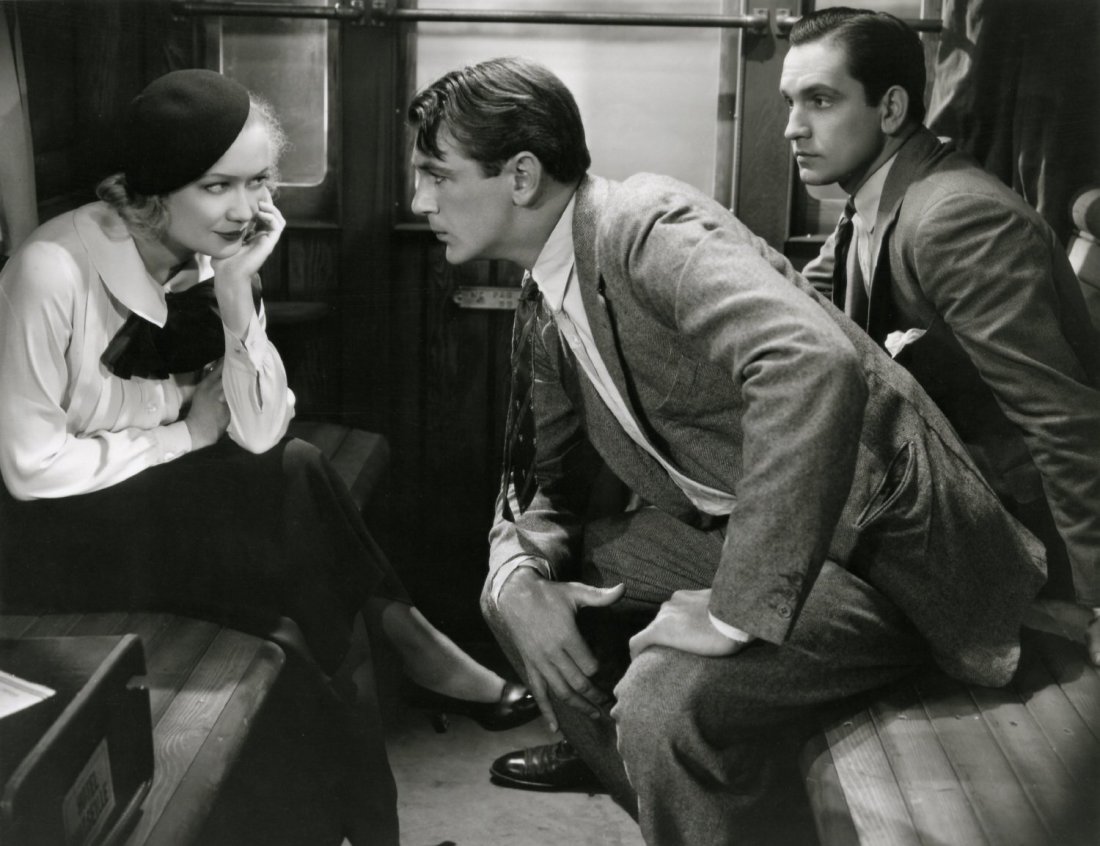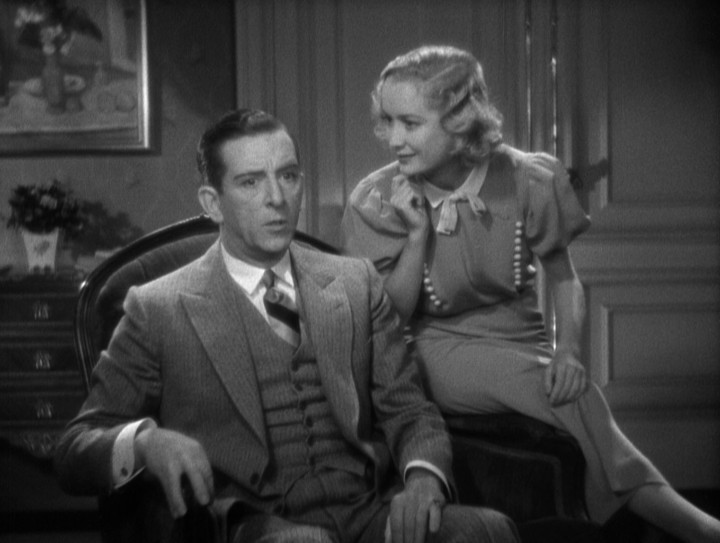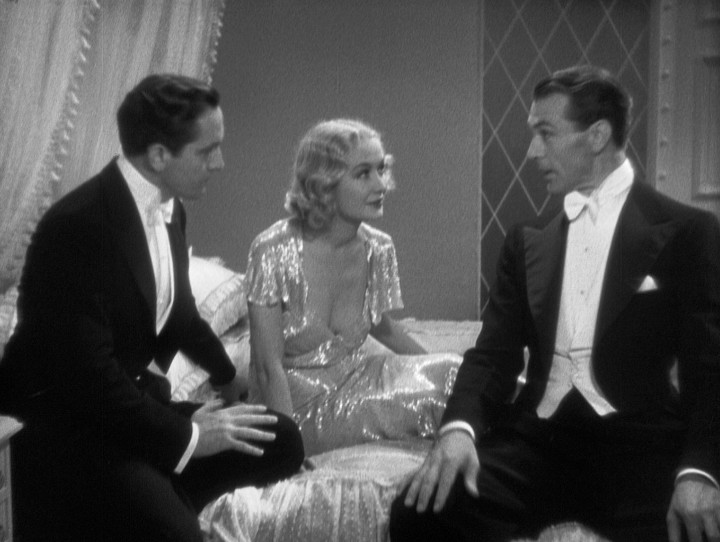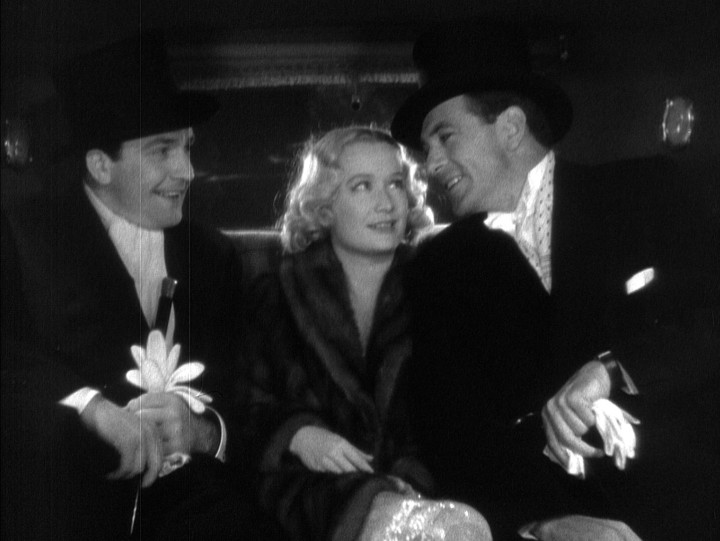Even while Design for Living fits in far better with the six features (and segments in two others) Lubitsch made in those years than it does with anything that follows, it has a slightly different feel to it. First of all, the heavy use of a musical track underscoring the action is nowhere to be found. More important, however is that it is probably the most “American” film he ever made, which seems odd considering that the film’s entire action takes place in Paris, London, and on a train passing through the French countryside. Yet all four of the film’s major characters are pointedly Americans living abroad. This is probably due in some part to the cast, especially Cooper, who was never conceivably anything but American (see the 1938 Adventures of Marco Polo).
However, a lot of this is attributable to Ben Hecht writing the screenplay—his only credited association with Lubitsch. What’s interesting is that Hecht’s wisecracking, roughneck cynicism and Lubitsch’s flair and his fabled “touch” go together very nicely. In fact, the oh-so-typical Lubitsch scene toward the end—when George and Tom in Hechtian fashion break-up a fancy soiree while the camera in (Lubitschian fashion) remains on the doors through which they entered—is one of the funniest in his filmography, yet it owes a good bit to Hecht. It’s unclear as to whether it was censorship, Lubitsch, or Hecht that made the screenplay use nothing but the title, premise, and single line (“good for our immortal souls”) from Coward’s play. Likely, all three enter into it, but it’s easy to imagine—despite Hecht’s own boughts of “artiness”—that Hecht delighted in rewriting the whole thing. Hecht had little patience with anything “high class” —unless it was his own, of course (you’ll note this didn’t keep him from casting Noel Coward in his own, very highbrow The Scoundrel two years later). And though it’s heresy to say this, I frankly think Hecht’s screenplay is considerably funnier and more clever than Coward’s play.
After this film, Lubitsch would go over to MGM (never a particularly smart move artistically) to make his final—and least—Maurice Chevalier-Jeanette MacDonald musical comedy The Merry Widow (1934). Following that, he took over as head of production at Paramount, a job that kept him out of the director’s chair for three years (unless you count his supervision on Frank Borzage’s Desire in 1936, which resulted in a movie that feels more like Lubitsch than Borzage — at least till the final reel). When he returned in 1937 with Angel something had changed. It and the movies that followed were still clearly his, but the sense of cinematic inventiveness was missing. Did three years as a studio executive do this? Maybe. Maybe it was just changing styles, since none of the great cinema stylists of the first half of the 1930s—Lubitsch, Sternberg, Whale, Mamoulian—were ever quite the same in the latter half of the decade. Whatever the case, we at least have those films from the early 1930s—and one of the best of them is Design for Living.







Was lucky enough to catch a screening of “Trouble in Paradise” at the NC Museum of Art in Raleigh Friday night. It’s another Lubitsch production, also with Hopkins and Horton, from 1932. Remarkably sophisticated dialog and plot structure for a romantic comedy.
Probably Lubitsch’s best film, too. We did it a while back. http://mountainx.com/movies/reviews/trouble-in-paradise/
Though i love Noel Coward, I am no purist. But when a film is touted as ” Noel Coward’s Design for Living” there is an expectation that the dialogue will be lifted from the play. If it wasn’t…then it is more Ben Hecht ‘s Design for Living. I have great respect for Ben Hecht. But on this film version of his play, Coward said, “I’m told that there are three of my original lines left in the film—such original ones as ‘Pass the mustard’. I am not opposed to adapting plays for film, but I am opposed to cashing in on Coward’s box office success to sell something that turns out to be another animal entirely. This isn’t being a purist by the way. It is being respectful of the work of a playwright who labored over every line to later see it morphed into something else.
I’ve read Design for Living. I’ll take this. Does the film trade on Coward’s name (for which, by the way, he was well paid)? Sure. Could the play have been filmed as written? Well, maybe. But it wouldn’t have made a very good movie — and that’s assuming you could get the play past the censors. That any vestige of the basic idea of a menage a trois got past them at all is amazing. Coward had been around. He knew the score where movies were concerned. The film of his Easy Virtue made in 1928 by Alfred Hitchcock has even less to do with the play. You’ll disagree with the idea, of course, but I’m of the Orson Welles school of thought that when you adapt a work, you’re pretty much free to do what you want with it, because it’s no longer the work, but your version of that work.
At the time this was made, Hollywood bought plays (and novels) based entirely on the public’s recognition value of the author’s name or the title. (Remember, especially then, the broader public not living in NYC or LA never had much chance to see these plays.) The classic example was when Sam Goldwyn bought Lillian Hellman’s The Children’s Hour because it was the hot topic on Broadway, not because he had a clue about what it was. When told that it was unfilmable because it was about lesbians, Goldwyn (whose mastery of English was never great) suggested, “We could always call them Bulgarians.”
I appreciate the historical context you have created for me as you school me once again in cinema history. I appreciate knowing that playwrights were selling their scripts to people who were cashing in on public recognition value. I have not seen the number of films you have, but one thing I have seen a lot of and that is adaptations from script to screen. I have seen plays adapted to film by Shakespeare, Tennessee Williams, Eugene O’ Neill, Arthur Miller, Neil Simon. George S Kaufman, and Ben Hecht to name a few. Though each play is adapted for screen, mostly by adding more locations for some of the scenes, the dialogue has mostly remained intact. Since my life’s work is the theater, and I am very familiar with the writing I can claim to be a bit of an expert on this.
“You’ll disagree with the idea, of course, but I’m of the Orson Welles school of thought that when you adapt a work, you’re pretty much free to do what you want with it, because it’s no longer the work, but your version of that work. ”
Thanks for letting me know what I will disagree with you on. I agree with you to a point. Directors and screenwriters will always endow a work with more visual choices for some of the scenes. But when one of the great playwrights sees 97% of his lines simply paraphrased, it is a travesty. AGAIN. Don’t call it Noel Coward’s Design for Living. Call it” based on ” etc,,,
I know you will disagree with me on this. I am fine with that.
While I have no wish to drag this out, I would be curious to know what Kaufman and Hecht plays you have seen adapted to film that did not have significant changes — far more than what is usually called “opening up the action.” I suppose the film of Hart and Kaufman’s Once in a Lifetime (1932) is fairly close — most of the changes are censorship ones, but it’s also almost never shown. (I have a bootleg copy taken from 16mm, but it’s only TV airing I can find was on PBS in 1970, which is where I first saw it.) You Can’t Take It with You (1938) is heavily ammended. The Man Who Came to Dinner (1942) has been Hollywoodized in the extreme — to the degree that Bette Davis’ Maggie Cutler has much additional footage to justify her top billing. George Washington Slept Here (1942) is all but unrecognizable beyond its central premise. As for Hecht…well, there are really only two plays — The Front Page and Twentieth Century. The 1931 film of The Front Page is a reasonably close (cleaned up version) of the play. The most famous version, His Girl Friday (1940), is not only even more cleaned up, but has 20-plus minutes of all new material by Charles Lederer added before it even gets to the play — not to mention that Hildy Johnson was turned into a woman’s role. The most recent version — Billy Wilder’s 1974 one — is no more faithful and is played like broad farce. We may omit, I think, the 1988 Switching Channels which moves the whole thing to a TV station with Burt Reynolds playing a Ted Turner-like character. (There was a taping of the B’way revival that was broadcast in 1971 and it was 90% faithful, if memory serves.) Twentieth Century was only filmed once. First of all, the play itself was an adaptation of someone else’s play, Napoleon of Broadway. The film — much like His Girl Friday — has about 30 minutes of added material at the beginning before the film even gets to the train of the title.
Most of the others you name are from a much later era of filmmaking and were prestige pictures. I doubt you’d find the 1932 film of Strange Interlude a faithful version of O’Neill. And there’s the 1935 Midsummer Night’s Dream, which was certainly prestige-oriented, but that prestige had much to do with Max Reinhardt’s then hot interpretation of the play where scenes were jumbled around and even the text re-arranged. I guess you could call the 1936 Romeo and Juliet faithful — except it has a 34-year-old Juliet and a 43-year-old Romeo. You have to consider these things in historical context. Well, you don’t have to, but it helps.
As for Design for Living, it’s even worse than paraphrased. It’s a complete re-write. Of course, the answer is simple — never see it. (From a legal standpoint, though, you’d have to call it “based on.”)
The plays I have seen made into films by Kaufman were STAGE DOOR ( which was rewritten for film, so this does nothing to help my case) and YOU CAN’T TAKE IT WITH YOU. I have directed the stage version of the latter twice, so I practically have the script memorized. The film script was faithful to the staged version. As for Ben Hecht, I am referring to FRONT PAGE. I worked on the stage version of that as well, and felt the film honored the original script for the most part.
The age of the actors has little to do with the topic. I have seen some Juliets that were long in the tooth. ( I performed the role for a group of educators one summer and was told ” I think this might be your last Juliet.” ) How a casting director chooses to cast his film is another topic for another day.
I get the historical context. I appreciate your knowledge and ability to illustrate your points through the events of the past.
I still don’t think it’s right. I guess it needs saying that this film in and of itself is not the issue. It is pawning it off as a Noel Coward script that bothers me. Historical context or not.
Kaufman would definitely have disagreed on Stage Door, which he said ought to have been retitled Screen Door. I know much has been added to the non-Sycamore house scenes of You Can’t Take It with You, but I suspect the film is a fair approximation of the play, though it drops some of my favorite small bits. It and The American Way are the Kaufman-Hart plays I only read once.
You thought the 1974 Front Page honored the play? Well, I’d never have said that.
The film of Design for Living clearly credits Ben Hecht with the script, not Coward. Does it trade on Coward’s name? Of course, that’s really what Paramount was paying for. To the public at large that meant sophisticated comedy, which this is. It also gets as close as possible to conveying the idea of a menage. Conceptually, it is Coward’s, though it’s been refigured for three big name American movie stars and the particular style of the filmmaker.